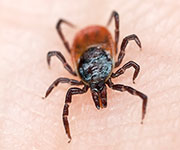- Navigating Your Midlife Crisis: Embracing New Possibilities
- City Raccoons Showing Signs of Domestication
- Mapping the Exposome: Science Broadens Focus to Environmental Disease Triggers
- One Week Less on Social Media Linked to Better Mental Health
- Your Brain Changes in Stages as You Age, Study Finds
- Some Suicide Victims Show No Typical Warning Signs, Study Finds
- ByHeart Formula Faces Lawsuits After Babies Sickened With Botulism
- Switch to Vegan Diet Could Cut Your Greenhouse Gas Emissions in Half
- Regular Bedtime Does Wonders for Blood Pressure
- Dining Alone Could Mean Worse Nutrition for Seniors
Tick Infection Epidemic Among American Indian Tribes in Arizona: CDC


An epidemic of Rocky Mountain spotted fever among several American Indian tribes on two reservations in Arizona has led to more than $13 million in societal costs in nine years, according to a new study.
That amount includes treatment, time off work, and loss of lifetime productivity due to early death.
The study likely underestimates the actual cost of the epidemic because it doesn’t include long-term losses from disability and expensive medical procedures, said researchers from the U.S. Centers for Disease Control and Prevention, Indian Health Services and the affected tribes.
Rocky Mountain spotted fever is caused by Rickettsia rickettsii bacteria and spread through the bite of an infected tick. The disease has only recently become a serious problem among American Indians in Arizona, according to the researchers. The brown dog tick, known to transmit the bacteria in Arizona, can be carried into homes by untreated dogs and other pets.
The researchers reviewed 205 cases of Rocky Mountain spotted fever that occurred among members of two tribes hardest hit by the epidemic. These cases occurred between 2002 and 2011. More than 80 percent of the cases required emergency room visits, the study found. About 14 percent of patients were admitted to the intensive care unit, and 7 percent of patients died.
The average cost per death from Rocky Mountain spotted fever is more than $775,000. Children account for more than half of deaths caused by the disease, the study authors said.
Overall, more than 300 cases of Rocky Mountain spotted fever and 20 deaths from the disease occurred on Arizona Indian reservations between 2002 and 2014, the researchers said.
The death rate for the illness is 20 percent, the researchers said, and the average time from the start of symptoms to death is eight days. Severely ill patients may have fingers, toes or limbs amputated due to blood loss. They may also need heart and lung specialty care, and management in an intensive care unit.
After someone is infected, the best way to prevent severe illness or death is immediate treatment with the antibiotic doxycycline, the researchers said.
There is no vaccine for the disease, and prevention must focus on preventing bites from infected ticks, according to the CDC.
Tribally run tick-control plans — including treating homes and lawns and placing tick collars on dogs — have been effective. But the cost of the programs have hindered control efforts, the CDC said. However, the long-term costs of failing to halt the epidemic could be far greater, the study authors said.
According to the study, prevention and early treatment of the disease could save millions of dollars by averting premature death and disability.
“Rocky Mountain spotted fever is completely preventable,” Naomi Drexler, a CDC epidemiologist and one of the study authors, said in an agency news release.
“State, federal and tribal health authorities have been working together since the start of the epidemic to build effective community-based tick control programs, and these efforts have produced remarkable reductions in human cases,” she added. “These programs are costly, but medical expenses and lives lost cost four times more than Rocky Mountain spotted fever prevention efforts. Increasing access to these prevention efforts is critical to save lives and protect communities.”
The study findings were published recently in The American Journal of Tropical Medicine and Hygiene.
More information
The U.S. Centers for Disease Control and Prevention has more on Rocky Mountain spotted fever.
Source: HealthDay
Copyright © 2025 HealthDay. All rights reserved.










